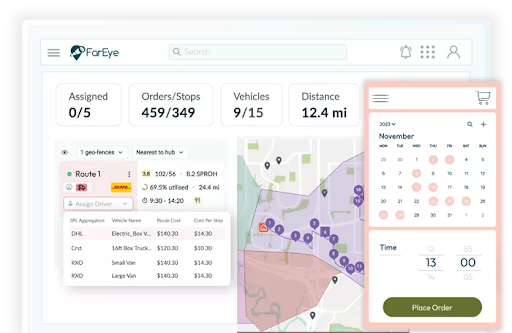- Route
What Role Does Scheduling Software Play in Optimizing Resource Allocation for Transportation?
Table of Contents
- The Heart of Efficient Transport: Resource Allocation
- Why Manual Scheduling No Longer Works
- Enter Scheduling Software for Transportation
- Unpacking Transport Scheduling Software’s Core Value
- The Big & Bulky Edge: Addressing Unique Delivery Challenges
- Real Impact: From Cost Savings to Customer Delight
- Choosing the Right Platform: What Sets FarEye Apart
- Scheduling Software as a Strategic Advantage

Today’s transportation landscape is marked by unpredictability, surging volumes, and the need for precise, cost-effective delivery execution. For dispatchers and supply chain managers, orchestrating daily routes is more than a matter of putting trucks on the road. Each decision is about who drives, which route, what time slot, and what load ripples across customer experience, operational cost, and sustainability outcomes.
Recent years have seen a surge in demand for home delivery, bulky goods shipping, and omni-channel fulfillment. According to a report, 62% of supply chain leaders see route planning and scheduling as a key area for efficiency gains. Yet, despite advances, nearly the majority of leaders struggle with suboptimal fleet utilization, rising fuel costs, and missed SLAs. In this environment, scheduling software for transportation is no longer optional; it's foundational.

The Heart of Efficient Transport: Resource Allocation
Resource allocation in transportation has always meant finding the best possible use for a limited set of assets: vehicles, drivers, time slots, and delivery windows. But what once relied on spreadsheets and manual calls now requires millisecond decisions powered by live data and advanced algorithms. The pressure to “do more with less” is constant.
Why Manual Scheduling No Longer Works
Manual scheduling fragments visibility slows responsiveness, and introduces errors. Dispatchers wrestle with late orders, last-minute cancellations, and the complexity of balancing delivery urgency, driver skills, and asset availability.
Spreadsheets rarely capture real-world constraints such as traffic, weather, vehicle maintenance, or the skill required for assembling large goods on-site. The result? Underutilized trucks, driver burnout, failed first attempts, and increased delivery costs.
Enter Scheduling Software for Transportation
This is where purpose-built scheduling software for transportation transforms the equation. By digitizing and automating the entire process, such software provides a live, unified view of resources and makes optimization continuous, not occasional. It ingests real-time inputs on order flow, capacity, driver rosters, restrictions, and customer preferences to generate actionable, cost-effective schedules.
Key Capabilities at a Glance:
- Dynamic route planning and real-time rescheduling
- Load and capacity balancing, including bulky and specialized items
- Automated driver and vehicle allocation based on skill, geography, and compliance
- Real-time ETA calculation, delay alerts, and customer communication
- AI/ML-powered forecasting for demand, disruptions, and asset allocation
Unpacking Transport Scheduling Software’s Core Value
Let’s break down exactly how the right transport scheduling software impacts daily fleet and resource decisions:
- Automated, Dynamic Scheduling
Every day, new variables enter the mix: rush orders, cancellations, traffic disruptions, or weather events. Advanced software recalibrates plans instantly, adjusting time slots, rerouting drivers, or consolidating loads.
For a dispatcher, this means less fire-fighting and more strategic oversight. Changes ripple automatically through the system, reducing manual intervention and minimizing costly errors. - Load and Capacity Optimization
The true cost of transportation isn’t just the miles driven; it’s the empty space, wasted fuel, and underutilized labor hours. Scheduling software for transportation uses real-time demand and historical data to fill trucks efficiently, pairing compatible orders and factoring in size, weight, and handling needs.
For big & bulky deliveries such as furniture or appliances, this becomes critical. The system considers assembly skills, two-person crews, and special vehicle requirements, all before the truck leaves the depot. - Precise Slot Management for Customer Convenience
Customers today expect flexibility and reliability. Transport scheduling software enables enterprises to offer dynamic delivery time slots, both before and after checkout.
With real-time updates on order volume, confirmed routes, and available drivers, companies can empower customers to select preferred windows or even reschedule with a few clicks. This reduces “assembly anxiety” and increases first-attempt delivery success. - Real-Time Visibility and Proactive Problem Solving
Missed SLAs and failed deliveries erode brand trust and drive up costs. Modern scheduling software centralizes all fleet activity order status, truck location, ETAs, and exceptions on a single dashboard.
Alerts notify dispatchers instantly of late vehicles, missed stops, or last-minute changes, enabling fast, targeted response. For owned, outsourced, and DSP-driven fleets alike, this centralized visibility is a force multiplier. - Intelligent Routing for Big & Bulky Deliveries
Bulky goods come with their own headaches: narrow delivery windows, complex assembly, skill-based crew matching, and strict SLAs. FarEye’s big & bulky routing platform goes further.
Routes are built not just on geography but on driver skills, vehicle constraints, and customer-chosen slots. The result: lower failed delivery rates, improved service times, and a seamless experience for both end customers and fleet managers. - Green Windows and Sustainable Scheduling
As ESG targets become central, companies are under pressure to offer sustainable delivery choices. With the right transport scheduling software, dispatchers can offer “Green Windows” time slots designed for consolidated routes, minimal backtracking, and lower carbon emissions. Encouraging customers to pick these options reduces the overall footprint while ensuring capacity is used efficiently. - Cost Control and Carrier Selection
Modern scheduling platforms support hybrid delivery models balancing owned fleets, outsourced carriers, and DSPs. Rate-based carrier selection ensures each route is assigned for the least cost while maintaining service quality. By tracking actual costs, performance, and reattempt rates, managers can fine-tune carrier selection in real time. - Data-Driven Forecasting and Continuous Improvement
AI and machine learning take scheduling beyond gut instinct. FarEye analyze historic order flows, seasonal spikes, and delivery outcomes to predict the number of drivers and vehicles needed per day.
Over time, this means fewer surprises, more efficient asset use, and the ability to scale without chaos. For furniture, appliances, and big-box delivery, this predictive power is indispensable. - Integrated Communication Across Stakeholders
Seamless delivery relies on more than just the right route; it's about keeping customers, drivers, and partners in sync. Automated updates via SMS, email, or app keep everyone informed, reducing “where is my order?” calls and enabling customers to adjust their availability if plans change. For field teams, mobile tools provide route updates, delivery instructions, and customer notes all in one place.
The Big & Bulky Edge: Addressing Unique Delivery Challenges
The stakes rise with large-format items. A missed sofa delivery isn’t just a customer inconvenience. It triggers expensive reattempts, impacts assembly schedules, and affects brand loyalty. Scheduling software for transportation must therefore:
- Map the right drivers and vehicles for two-person, skill-based assembly tasks.
- Plan routes accounting for road and vehicle restrictions.
- Factor in service times, assembly windows, and on-site requirements
- Consolidate returns and update routes efficiently.
- Offer branded customer portals for slot booking and real-time tracking.
With FarEye’s big & bulky routing solution, brands can elevate the customer experience, reduce failed delivery rates, and optimize capacity across the first and last mile. By aligning service windows with customer preferences and operational realities, the platform helps fleets achieve cost savings while boosting on-time delivery rates.
Real Impact: From Cost Savings to Customer Delight
When resource allocation is optimized through smart scheduling software, the benefits are immediate and measurable:
- Reduced Costs: Efficient routing and capacity planning minimize fuel and overtime expenses.
- Higher On-time Delivery: Automated scheduling ensures more orders are delivered within SLA windows, driving up satisfaction.
- Fewer Failed Attempts: Dynamic slot management and precise ETAs help customers be ready, reducing expensive re-deliveries.
- Improved Driver Retention: Balanced routes and clear instructions lower stress and fatigue, keeping skilled teams longer.
- Better Sustainability: Green windows and consolidated loads shrink environmental impact.
Choosing the Right Platform: What Sets FarEye Apart
As companies scale up, flexibility and intelligence become non-negotiable. FarEye’s scheduling software for transportation integrates with existing TMS, WMS, and CRM systems, providing end-to-end visibility from order intake to doorstep delivery. AI-based routing ensures every truck, driver, and slot is optimally used no matter the complexity of your operation.
FarEye’s platform also empowers enterprises to:
- Support white-glove and oversized deliveries
- Maximise both first-mile and last-mile efficiency
- Offer branded customer experiences with real-time tracking
- Handle returns and capacity consolidation seamlessly
- Maintain service quality, even during peak volume
Scheduling Software as a Strategic Advantage
Transportation isn’t just about moving goods; it’s about orchestrating every resource for speed, savings, and customer delight. Scheduling software for transportation is the foundation of this orchestration, especially as fleets grow, customer expectations shift, and the pressure for cost and sustainability intensifies.
For dispatchers and supply chain managers, embracing the right platform isn’t just about keeping pace. It’s about setting the pace for an industry that demands flexibility, intelligence, and relentless focus on service quality. In that mission, transport scheduling software is transforming the future of transport, one route, one delivery, and one satisfied customer at a time.
Source:
https://www.gartner.com/en/supply-chain/topics/supply-chain-logistics-management

Komal Puri is a seasoned professional in the logistics and supply chain industry. As the AVP of Marketing and a subject matter expert at FarEye, she has been instrumental in shaping the industry narrative for the past decade. Her expertise and insights have earned her numerous awards and recognition. Komal’s writings reflect her deep understanding of the industry, offering valuable insights and thought leadership.
Let's Talk to Our Experts and Optimize Your Deliveries Today!
An expert from our team will reach out within 24 hours


